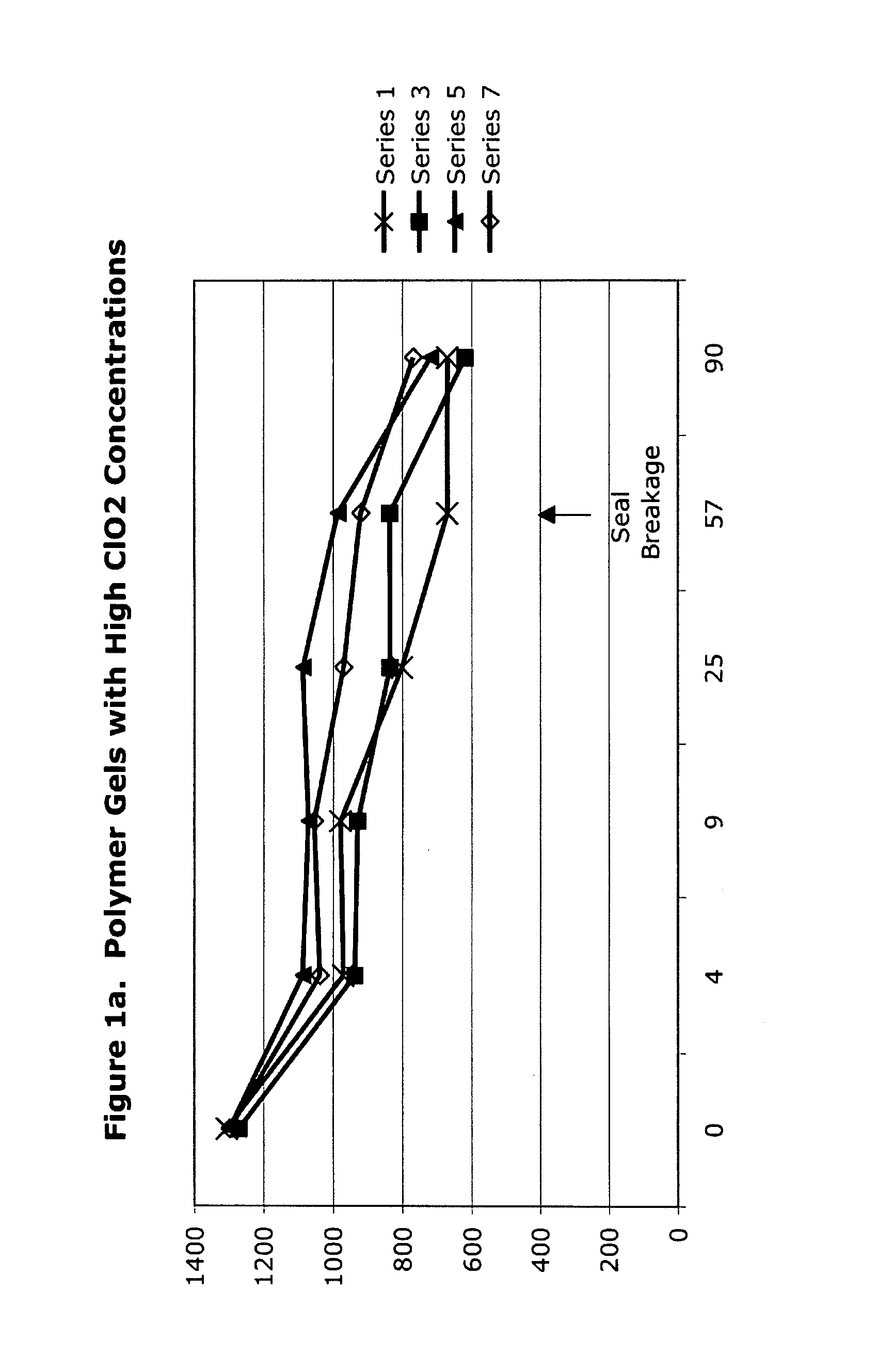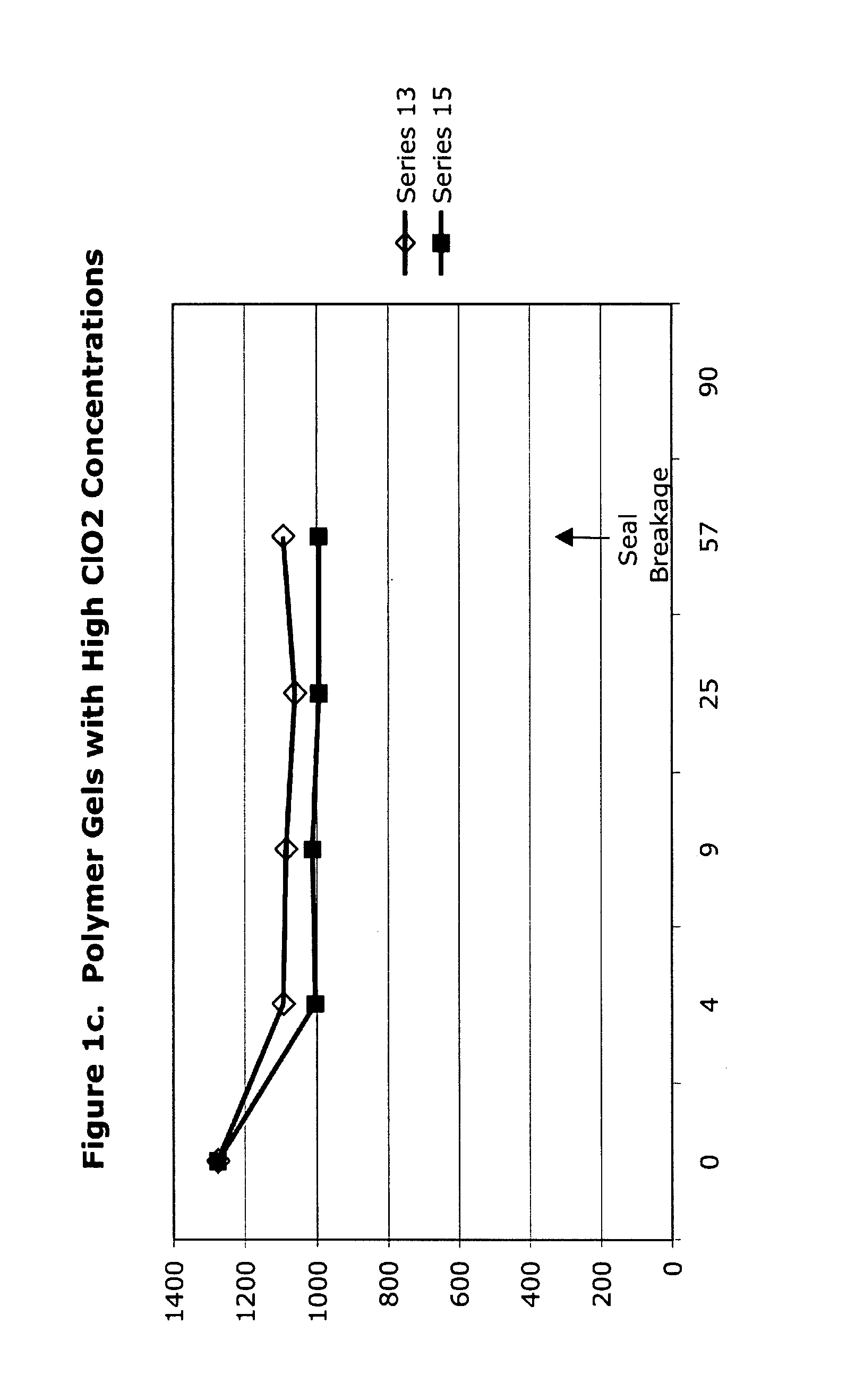Chlorine dioxide gel and associated methods
a technology of chlorine dioxide and chloride gel, which is applied in the direction of chlorine active ingredients, biocide, drug compositions, etc., can solve the problems of high toxicity, ineffective disinfection of gram-positive bacteria, and high degree of undesirable side effects
- Summary
- Abstract
- Description
- Claims
- Application Information
AI Technical Summary
Benefits of technology
Problems solved by technology
Method used
Image
Examples
example 1
[0041]Two types of polymer, the sodium and potassium salts of poly(acrylic acid), were used to form gels. The aqueous chlorine dioxide was prepared according to the method of the '861 and '135 patents, producing a chlorine dioxide concentration of 4522 mg / L, this being diluted as indicated.
[0042]The gels were formed by mild shaking for 2 min in an open clock dish, the gels then transferred to amber glass bottles, leaving minimum headspace, sealed, and stored in the dark. The aqueous controls were stored in both clear and amber bottles. After 3 days it was determined that the gels retained the original color and consistency, and were easily degelled. Table 1 provides data for 3 and 90 days, illustrating that little concentration loss occurred. The samples after 3 days were stored under fluorescent lighting at approximately 22° C.
[0043]
TABLE 1Chlorine Dioxide Gels in 3- and 90-Day Storage, Concentrations in ppmClO2PolymerInitialClO2 Conc.ClO2Amt.Amt.ClO2After 3Conc. AfterProd.Containe...
example 2
[0047]Gels formed by five different polymers, each having their formed gels stored in clear and amber containers, were compared when stored under different conditions. Table 2 provides the results of these experiments.
[0048]
TABLE 2Results of Experiments of Example 2# of Days10142128323951102CONTROL 1407414380332312282288277STDEV0.011.7125.911.75.95.96.6CONTROL 2332271278261265292282280STDEV11.723.5125.910.211.715.510.0CONTROL 3286241229225221233225219STDEV0.00.00.06.66.66.66.65.9HALF331292280235254263205144BOTTLESTDEV25.711.6910.410.212.67.87.1Polymer A257248236214208208201197STDEV12.87.4714.86.49.87.48.8Polymer B228216208196198194192184STDEV0.00.076.912.06.912.06.5Polymer C-1317283278266270278270271STDEV7.412.877.411.17.412.910.2Polymer C-2287291287261257259257254STDEV7.47.477.40.03.70.04.9PPM lost due4631493643595661to separation ofpolymer(CONTROL 2-CONTROL 3)Average = 48CONTROL 1: Full amber bottle with polymer (no agitation)CONTROL 2: Full amber bottle prepared with polymer samp...
example 3
[0050]High-concentration (1425 ppm) aqueous chlorine dioxide was used to form polymer gels as listed in Table 3 in this set of experiments, the results of which are given in Table 4 and FIGS. 1a to 1f. The initial loss of concentration strength is due to dilution and procedural exposure, during preparation and analysis, to ambient air, not to decomposition based upon interaction between the polymer and the chlorine dioxide.
[0051]
TABLE 3Sample Preparation Information for Gel Technology(High Concentration)SamplesBottleGellantHDAAmberPolymer AHDBAmberPolymer BHDCAmberPolymer C-1HDDAmberPolymer C-2HDEAmberPolymer C-3HDFAmberControl 1HDGAmberControl 2HDHAmberControl 3HDIClearPolymer AHDJClearPolymer BHDKClearPolymer C-1HDLClearPolymer C-2HDMClearPolymer C-3HDNClearControl 1HDOClearControl 2HDPClearControl 3Note:All sample bottles are full, and stored at room temperature under fluorescent light.
[0052]
TABLE 4ClO2 Analysis Data of ClO2 GelsTRTInitial4 d9 d25 d57 d90 dSeriesHDA14251306971979...
PUM
| Property | Measurement | Unit |
|---|---|---|
| concentration | aaaaa | aaaaa |
| particle size | aaaaa | aaaaa |
| temperature | aaaaa | aaaaa |
Abstract
Description
Claims
Application Information
 Login to View More
Login to View More - R&D
- Intellectual Property
- Life Sciences
- Materials
- Tech Scout
- Unparalleled Data Quality
- Higher Quality Content
- 60% Fewer Hallucinations
Browse by: Latest US Patents, China's latest patents, Technical Efficacy Thesaurus, Application Domain, Technology Topic, Popular Technical Reports.
© 2025 PatSnap. All rights reserved.Legal|Privacy policy|Modern Slavery Act Transparency Statement|Sitemap|About US| Contact US: help@patsnap.com



